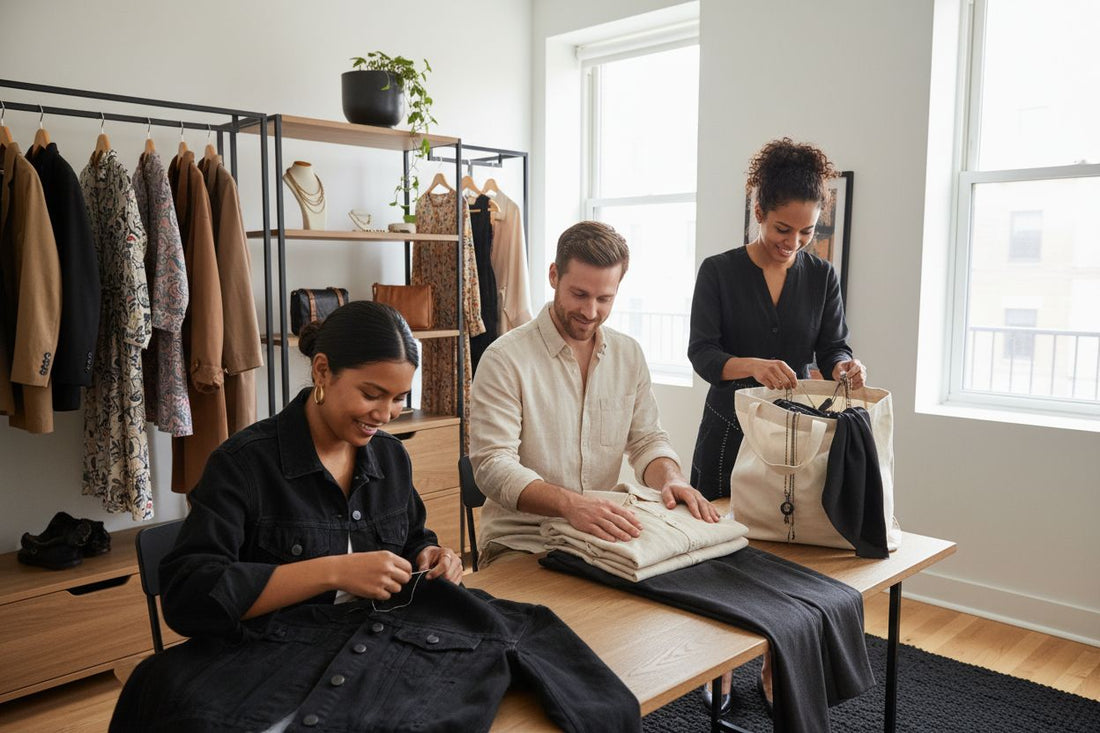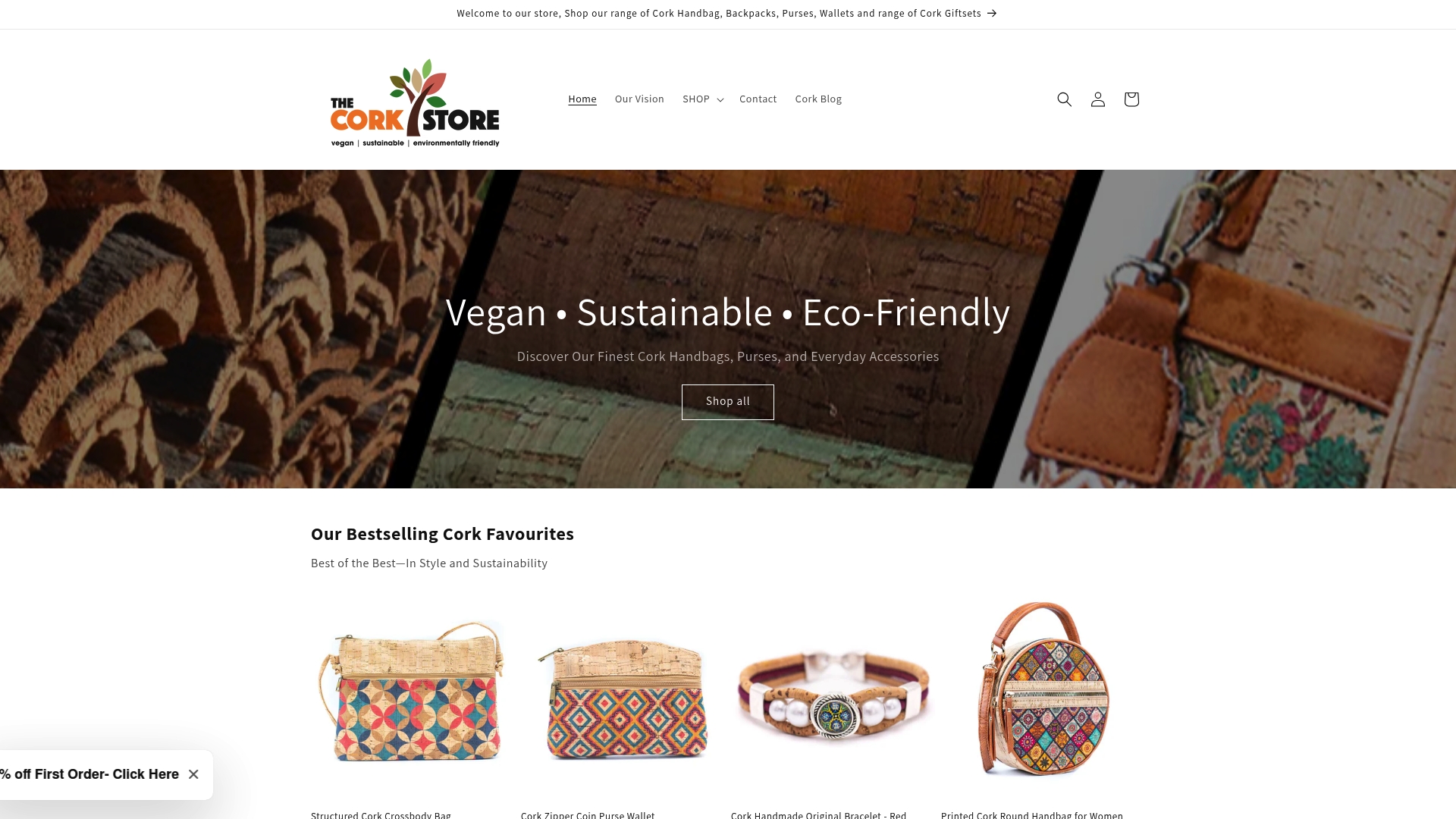
7 Practical Ways to Reduce Fashion Waste for a Greener Closet
Share
Did you know the world throws away over 92 million tonnes of clothing each year? Many closets are overflowing, yet few people wear most of what they own. Shifting towards sustainable fashion is not just a passing trend. It is a necessary response to an industry known for waste and pollution. Simple changes in shopping and wardrobe habits can save money, reduce waste, and help protect the planet with every choice you make.
Quick Summary
| Takeaway | Explanation |
|---|---|
| 1. Prioritize quality over quantity in fashion choices | Invest in high-quality clothing that lasts longer, reducing fashion waste and environmental impact. |
| 2. Support brands that use sustainable materials | Choose companies committed to eco-friendly fabrics, driving demand for responsible fashion production. |
| 3. Embrace secondhand shopping and clothing swaps | Opt for secondhand clothing to save money, lower your carbon footprint, and reduce textile waste. |
| 4. Practice upcycling for old accessories | Create new items from unused accessories, giving them a second life and minimizing waste. |
| 5. Care for your clothes to extend their lifespan | Maintain garments through proper laundering and storage to reduce the need for replacements and facilitate sustainable fashion. |
Table of Contents
- Choose Quality Over Quantity In Your Wardrobe
- Support Brands Using Sustainable Materials
- Buy Secondhand Or Swap Fashion Items
- Repurpose Or Upcycle Old Accessories
- Care Properly For Your Clothes And Bags
- Donate Or Recycle Unwanted Fashion Items
- Opt For Timeless, Versatile Styles That Last
1. Choose Quality Over Quantity in Your Wardrobe
Transforming your wardrobe from fast fashion chaos to a curated collection of exceptional pieces starts with one powerful principle: quality trumps quantity. Embracing this approach is not just a style statement but a significant step towards reducing fashion waste and creating a more sustainable closet.
According to research from sustainable fashion experts, high quality clothing is constructed with meticulous attention to detail and using durable fabrics. This means each garment you carefully select becomes an investment that dramatically reduces textile waste. By choosing well made pieces, you effectively lower the demand for constant new production and minimise the environmental impact of your fashion choices.
How Quality Clothing Makes a Difference:
- Lasts significantly longer than cheap, trend driven items
- Reduces frequent clothing replacements
- Minimises synthetic fabric pollution
- Encourages more mindful shopping habits
Implementing this strategy requires a shift in shopping mindset. Instead of purchasing multiple cheap items that quickly wear out, focus on acquiring fewer pieces crafted with superior materials and exceptional craftsmanship. Look for clothing with strong seams, quality fabric weights, and timeless designs that transcend seasonal trends.
When shopping, ask yourself key questions: Will this piece last multiple seasons? Is it versatile enough to pair with multiple outfits? Does the construction feel solid and well made? By becoming a more discerning consumer, you not only build a more sophisticated wardrobe but also contribute to reducing global textile waste.
Remember that investing in quality does not mean breaking the bank. Seek out sales from reputable brands, explore secondhand luxury markets, and prioritise pieces that offer exceptional cost per wear value. Your wallet and the planet will thank you.
2. Support Brands Using Sustainable Materials
Your shopping choices have incredible power. By intentionally supporting brands committed to sustainable materials, you become an active participant in transforming the fashion industry’s environmental impact.
Innovative materials are revolutionising textile production. Take our guide on sustainable materials for instance. Brands are now developing extraordinary alternatives that dramatically reduce environmental harm. Consider Bananatex, a biodegradable canvas fabric crafted from Abacá banana plant fibres. This remarkable material offers a renewable alternative to traditional synthetic textiles, demonstrating how natural resources can be transformed into high performance fabrics.
Why Supporting Sustainable Material Brands Matters:
- Reduces demand for environmentally harmful textile production
- Encourages innovation in eco friendly manufacturing
- Supports circular economy principles
- Drives market demand for responsible fashion
Companies like AMSilk are pushing boundaries by producing biosynthetic silk through bacterial fermentation. These materials can biodegrade in seawater and on land creating textile solutions that do not compromise environmental integrity. When you choose brands prioritising such materials you are voting with your wallet for a more sustainable future.
To support sustainable material brands start by researching companies transparent about their production processes. Look for certifications like Global Organic Textile Standard or Cradle to Cradle. Read brand sustainability reports. Ask questions about material sourcing. Follow sustainable fashion blogs and influencers who highlight innovative brands making genuine environmental commitments.
Remember that every purchase is an opportunity to support positive change. Your choices matter more than you might realise in driving systemic transformation towards more responsible fashion production.
3. Buy Secondhand or Swap Fashion Items
Turning your wardrobe into an eco friendly powerhouse can be as simple as rethinking where you source your clothes. Secondhand shopping and clothing swaps are game changing strategies for reducing fashion waste and minimising environmental impact.
How to spot sustainable fashion starts with understanding the incredible environmental benefits of reusing textiles. Research reveals that reusing just one tonne of textiles can save approximately 8 tonnes of CO₂ equivalent emissions and around 164 GJ of energy compared to producing brand new textiles.
Benefits of Secondhand and Swapped Fashion:
- Dramatically reduces textile waste
- Lowers personal carbon footprint
- Saves money on clothing purchases
- Creates unique personal style
Life cycle assessments demonstrate compelling environmental advantages. Secondhand consumption generates up to 42% lower climate change impact and cumulative energy demand. Additionally, it produces 35 to 53% lower water scarcity footprint per use compared to purchasing new items.
To get started, explore local and online secondhand marketplaces. Platforms like Facebook Marketplace, Depop, and ThredUp offer extensive collections. Attend clothing swap events in your community or organise one with friends. Consignment shops and vintage stores provide curated selections of pre loved fashion.
Be strategic in your approach. Check item conditions carefully. Look for quality pieces that align with your personal style. Consider the potential of minor repairs or alterations to refresh secondhand finds. By embracing pre owned fashion, you are not just making a style statement but contributing to a more sustainable fashion ecosystem.
4. Repurpose or Upcycle Old Accessories
Transforming old accessories into something new and exciting is not just a creative endeavour but a powerful strategy for reducing fashion waste. Upcycling turns forgotten items into treasured pieces with renewed purpose and personal significance.
Understanding sustainable fashion essentials reveals that innovative recycling can dramatically reduce waste. Consider the extraordinary example of an engineering student who transformed non recyclable red Solo cups into wearable textiles creating an entirely new textile from materials previously considered waste.
Upcycling Possibilities for Accessories:
- Convert old scarves into handbag handles
- Transform worn leather into decorative patches
- Create jewellery from broken accessories
- Repurpose fabric remnants into hair accessories
International initiatives demonstrate the incredible potential of upcycling. In Kenya organisations like Africa Collect Textile and AfroWema are pioneering approaches that transform unsellable second hand clothes into new fashion pieces and uniforms. This not only diverts textile waste but also generates sustainable local employment opportunities.
To start your upcycling journey, assess your existing accessories with fresh eyes. A worn leather wallet might become a stylish phone case. An old silk scarf could transform into elegant cushion covers. YouTube tutorials and craft websites offer abundant inspiration for breathing new life into seemingly obsolete items.
Upcycling requires creativity more than technical skill. Start small. Experiment. Learn from mistakes. Your unique approach might create something more meaningful than a mass produced accessory. By reimagining instead of discarding you reduce waste and express your individual style.
5. Care Properly for Your Clothes and Bags
Your clothing and accessories are more than just fabric and material. They are investments that deserve thoughtful maintenance to extend their lifespan and reduce overall fashion waste. Proper care can transform your wardrobe from disposable to durable.
How to style vegan handbags is just one aspect of sustainable fashion care. Experts emphasise that selecting durable fabrics and maintaining them carefully helps prevent premature disposal and significantly reduces fashion waste.
Essential Care Strategies for Clothing and Bags:
- Read and follow fabric care labels carefully
- Wash clothes less frequently
- Use gentle cleaning methods
- Store items properly to maintain shape
- Repair instead of replacing
Proper clothing maintenance involves more than just occasional washing. Consider air drying your garments instead of machine drying to prevent fabric stress and shrinkage. Learn basic repair skills like sewing buttons or patching small tears. These simple actions can extend a garment’s life by months or even years.
For bags and accessories, storage matters immensely. Keep leather items away from direct sunlight. Stuff bags with tissue paper to maintain their shape. Use dust bags or cotton pillowcases to protect delicate materials from dust and potential damage.
Remember that sustainable fashion is not about perfection but consistent mindful choices. Small actions like gentle washing gentle handling and timely repairs can dramatically reduce your fashion waste footprint. Your wardrobe will thank you both aesthetically and environmentally.
6. Donate or Recycle Unwanted Fashion Items
Every piece of clothing has a potential second life beyond your wardrobe. Responsible donation and recycling are powerful strategies for minimising fashion waste and supporting circular economy principles.
Understanding the role of eco friendly materials begins with recognising that responsible textile disposal matters more than you might think. While only a minority of donated clothing gets resold, strategic donation can still create meaningful environmental and social impact.
Smart Donation and Recycling Strategies:
- Research local clothing donation centres
- Check textile recycling programmes in your area
- Ensure items are clean and in good condition
- Separate clothing by material type
- Consider specialised recycling for specific fabrics
Life cycle assessments confirm that reuse significantly reduces environmental impacts compared to disposal or manufacturing new textiles. When donating, prioritise community focused outlets that have transparent processes. Local shelters women’s centres and community programmes often welcome clothing donations that are clean and in wearable condition.
For items too worn for direct donation textile recycling programmes can transform materials into industrial rags insulation or new fabric blends. Many cities now offer specialised recycling bins or collection events for textiles that cannot be resold.
Be strategic and thoughtful. Not all donated clothing finds a new home some ends up in landfills. By carefully selecting donation destinations and preparing your items responsibly you can maximise the potential for your unwanted fashion to create positive change.
7. Opt for Timeless, Versatile Styles That Last
Building a sustainable wardrobe is an art of selecting pieces that transcend fleeting trends and serve multiple purposes. Timeless fashion is about investing in versatile styles that remain elegant and functional across seasons and occasions.
Check out the latest sustainable fashion trends to understand how smart design can reduce waste. Research reveals that extending a garment’s lifespan by just nine months can dramatically cut carbon water and waste footprints by 20 to 30 percent.
Characteristics of Timeless Wardrobe Pieces:
- Classic cuts and neutral colours
- High quality materials
- Minimal design elements
- Easy to mix and match
- Adaptable across different settings
Choosing high quality designs reduces the constant pressure to chase seasonal trends. Instead of purchasing multiple cheap items that quickly become obsolete focus on acquiring versatile pieces that can be styled in numerous ways. A well tailored blazer neutral trousers or a simple cotton shirt can be transformed with different accessories creating multiple outfits from a single garment.
Consider your personal style as an evolving collection rather than a disposable commodity. Invest in clothing that reflects your personality while maintaining functional elegance. Neutral palettes like beige white and navy offer maximum versatility allowing you to create numerous combinations with minimal pieces.
Remember that sustainable fashion is not about perfection but making intentional choices. Your wardrobe can become a curated collection of pieces that tell a story reduce waste and express your unique style.
Below is a comprehensive table summarising the main strategies for sustainable wardrobe management discussed throughout the article.
| Strategy | Implementation | Expected Results |
|---|---|---|
| Choose Quality Over Quantity | Invest in durable, well-made pieces instead of numerous cheap items. | Reduces textile waste, promotes sustainable fashion. |
| Support Brands Using Sustainable Materials | Buy from brands using innovative, eco-friendly materials. | Encourages responsible production and reduces environmental harm. |
| Buy Secondhand or Swap Fashion Items | Participate in secondhand shopping and clothing swaps. | Decreases fashion waste and lowers carbon footprint. |
| Repurpose or Upcycle Old Accessories | Transform old items into new, creative pieces. | Reduces waste; creates personalised fashion items. |
| Care Properly for Your Clothes and Bags | Follow proper maintenance practices like gentle washing and correct storage. | Extends the lifespan of garments, reducing overall waste. |
| Donate or Recycle Unwanted Fashion Items | Use responsible donation and recycling channels for clothing disposal. | Supports circular economy and minimizes environmental impact. |
| Opt for Timeless, Versatile Styles That Last | Select classic, versatile designs that stay stylish beyond seasonal trends. | Reduces need for frequent replacements, promoting sustainability. |
Take Action for a Greener Closet with Sustainable Accessories
Are you frustrated by how difficult it is to reduce fashion waste while building a wardrobe that truly reflects your values? If you are seeking long-lasting, cruelty-free alternatives and want to make better choices for the planet, now is the time to act. The article has shown the real difference that quality materials, timeless designs, and conscious shopping can make. Imagine transforming your accessory collection into something that is not only stylish but also genuinely eco-friendly. By choosing durable and ethical accessories, such as those made from cork, you can address the environmental impact of fast fashion and take a meaningful step towards a greener future.

Visit The Cork Store today and discover a stunning range of vegan cork handbags, backpacks, wallets, and purses that align perfectly with your sustainability goals. Each product is crafted to last, designed without animal cruelty, and made to help you cut down on needless waste. Do not just read about changing your habits—make it happen now and enjoy eco-conscious accessories that look good and do good. Explore our collection and find your new favourite guilt-free accessory today at thecorkstore.co.uk.
Frequently Asked Questions
How can I choose quality over quantity in my wardrobe?
Emphasize selecting high-quality garments instead of numerous cheap items. Focus on pieces made from durable fabrics and timeless designs to reduce fashion waste and extend their lifespan.
What are the benefits of supporting brands that use sustainable materials?
Supporting brands that prioritize sustainable materials reduces the demand for environmentally harmful production and encourages innovation in eco-friendly manufacturing. To make an impact, research companies committed to sustainable practices and select those that openly share their material sourcing information.
How do I start buying secondhand or swapping fashion items?
Begin by exploring local thrift stores, online marketplaces, or participating in clothing swap events with friends. This approach significantly reduces textile waste while allowing you to discover unique pieces for a lower cost.
What are some creative ways to repurpose or upcycle old accessories?
Consider transforming items like old scarves into handbag handles or turning worn leather into decorative patches. Start by assessing your current accessories and experimenting with simple DIY projects to give them a new life.
How can I properly care for my clothes and bags to extend their lifespan?
To maintain your clothing and bags, follow the care instructions on labels, wash less frequently, and store items properly. Implementing these practices can significantly reduce the need for premature replacements and prolong your garments’ usability by several months.
What are effective strategies for donating or recycling unwanted fashion items?
Smart donation involves researching local centers that accept clothing and ensuring items are clean and in good condition. If clothing is too worn to donate, seek out textile recycling programs that can repurpose the materials into new products, reducing overall waste.
Recommended
- 7 Key Sustainable Fashion Trends 2025 for Eco Shoppers – The Cork Store
- Understanding Sustainable Fashion Essentials for Eco-Conscious Living – The Cork Store
- How to Spot Sustainable Fashion: A Step-by-Step Guide – The Cork Store
- Understanding the Role of Eco-Friendly Materials in Fashion – The Cork Store
